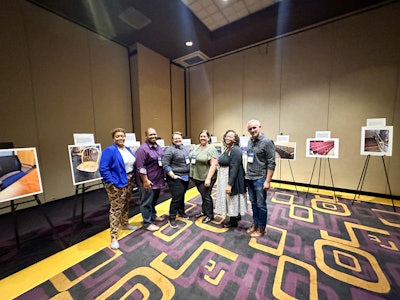By Terah J. Stewart, Roshaunda L. Breeden, Joan N. Collier, Meg E. Evans, Daniel J. Scanlon, Rachel L. Wagner, Erin R. Weston
In the classic fairy tale Goldilocks and the Three Bears readers are introduced to a little girl who happens upon a cottage in the forest where she boldly invites herself inside to explore. While there is much to learn and critique from the themes of her story, the part that is most striking to our author team is the intentional focus on space and fit. Particularly when considering how two of the chairs that Goldilocks sought to rest in were too big, but the third was just right. There is a similar refrain when Goldilocks tries to sleep in three different beds - again in a home where she was uninvited - before finding one was too hard, another too soft, yet the final bed was perfect for her.
One takeaway of this story is the obvious yet powerful assertion that not all of us have the same body and as such not all of us will navigate space or find fit the same. Goldilocks’ struggle to find fit should be unsurprising as the cottage was not her home, so she should not have expected to find comfort in that space. We write today centering the needs and experiences of fat students who sometimes struggle to find fit and space within academia. Fat students, an often hyper(in)visible population, find themselves having experiences that range from uncomfortable to violent within their classrooms and learning environments.  Terah J. Stewart, Roshaunda L. Breeden, Joan N. Collier, Meg E. Evans, Daniel J. Scanlon, Rachel L. Wagner & Erin R. Weston
Terah J. Stewart, Roshaunda L. Breeden, Joan N. Collier, Meg E. Evans, Daniel J. Scanlon, Rachel L. Wagner & Erin R. Weston
Scholars, activists, and practitioners use many terms (e.g., fatphobia, sizeism, and fat-hate) when discussing the structural oppression fat people face. For our purposes, we lean on Fat Activist Aubrey Gordon’s use of the terms anti-fatness and anti-fat bias. Gordon defines these terms as “the attitudes, behaviors, and social systems that specifically marginalize, exclude, underserve, and oppress fat bodies. They refer both to individual bigoted beliefs as well as institutional policies designed to marginalize fat people.” The nuance of this definition should be noted, with a key emphasis on institutions. While a significant body of the literature within fat studies focuses on what we describe as social experiences (bigoted beliefs), within higher education less attention has been given to related systems and structures, including campus spaces and environments.
As a group of scholars and researchers we were interested in such a focus and established the #FatOnCampus research project. Through our work we found that when given the chance to document their experiences fat students overwhelmingly focus on the ways they do not fit in furniture, chairs, and generally within classroom spaces. Fat students’ experiences range from discomfort to stigma and physical pain, all while they are expected to learn. These experiences are due in large part to sizeist structures that suggest there is a “normal type of body” of which most people, if not all, should be expected to fit within. One student described the difficulty of needing to fit into a chair with an attached and non-adjustable desk by talking about the lack of back support and how squeezing into the chair cut into their stomach. Another student described a similar seating arrangement and how the seat “pushes you against the table, it hurt(s).”
In a 2018 article titled, "About Fat Campus" students also articulated similar experiences.
For example, Rowena stated: "The constant physical discomfort from having to squish into a space that was too small was difficult and emotionally I suffered. I was frustrated because…all I wanted to do was attend my class and learn like other students." (Stewart, 2018, p. 32).
Until campus leaders can move to rectify campus spaces and furniture to more closely meet the needs of fat students, we encourage all faculty, teaching assistants, and student affairs practitioners who are charged with creating learning experiences to consider how they might manage these realities and help shift them for fat students. For example, consider the use of a Students of Size policy for inclusion in class syllabi or in programmatic handbooks/manuals that students can rely on to comfortably communicate their physical needs in classrooms and learning experiences.
Dr. TJ Stewart on our author team uses the following statement on his syllabi and within his work with students.
"Fat Students & Students of Size | The reality is that many campus buildings and structures are either out of date and/or they have furniture or classroom structures that are not friendly or conducive for fat people or people of size. I always do my best to mitigate these issues but may not always be successful. At any time if you find yourself experiencing discomfort (physical or otherwise) particularly related to body-size as a result of fatphobic, anti-fat, or sizeist structures please let me know immediately. I will work with you on a solution or accommodations including finding suitable furniture, requesting a classroom change, or another alternative - so that you can have a better learning environment."
This statement does a few different important things. First, it communicates to students educators’ understanding of the systemic and structural nature of anti-fat bias. Next it articulates educators’ interest in supporting these students to find imperfect solutions to difficult problems. Finally, the statement helps hold educators accountable. It could be the case that a student never takes advantage of such a policy but having this reality acknowledged, and some form of recourse available, can make all the difference. Such a policy also eases some of the discomfort fat students may feel in needing to advocate on their own and they may view such a policy as an invitation to dialogue and take action.
The negative experiences previously outlined are not uncommon and while fat students will continue to show up to their colleges and universities to pursue their education, they should be able to do so without physical pain or violence. In a perfect world, campuses would have designs with the needs of body-diverse students in mind. However, the reality is that issues of fatness are not currently rendered as justice issues within the world broadly, or higher education specifically. This is to say the prevalent paradigm around fat bodies is that fat people should simply change their body to fit. As a team we want to be clear that our views are unequivocal: fat bodies deserve to exist as they are. Fat bodies on and off campus deserve access to all the things non-fat bodies have. As Fat poet Rachel Wiley stated: "I do not owe you shrinking. I do not owe you thinness, attempted thinness, or desired thinness; because you assume thinness equals health. For that matter, I do not owe you health (perceived or otherwise) to receive basic respect. I am deserving of care. I am deserving to exist, as I do."
Unlike Goldilocks, fat students should not be viewed as intruders within higher education. They are not guests; fat students are part of our community and should be able to fit comfortably so they can do their part as learners. We invite you to join our efforts to support fat students in dynamic, meaningful, and material ways.
To learn more about our work and engage with the photovoice project, please visit fatoncampus.com


















